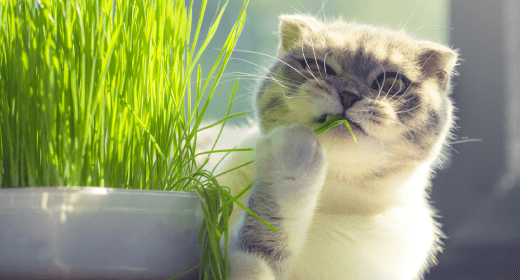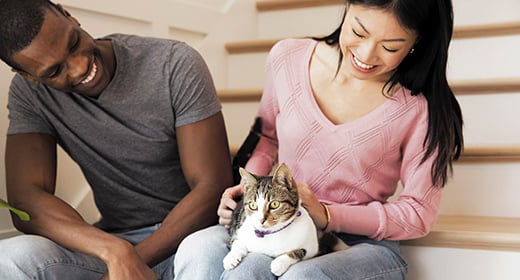

Fiber is a type of carbohydrate that isn't digested by a cat's gastrointestinal tract. It is important for cat health, because it provides bulk to move food through. Some types of fiber can be fermented (broken down by bacteria) in the system. This process creates short-chain fatty acids (SCFA), which are an important energy source for the cells lining the intestinal tract.
Today, people are more aware of fiber and its role in their diet. Studies showing the beneficial effects of higher fiber levels in humans influence the way many people think about their own food and that of their pets. Some manufacturers now apply the recommendations of human nutritionists and make high-fiber diets for cats, but cats have a much shorter digestive tract than we do. And unlike humans, cats are carnivorous, so their nutritional needs are better satisfied with meat rather than plant matter. Therefore, cats have different dietary needs than humans. For more than 60 years, companion animal nutritionists at IAMS™ have been studying diets to meet the special nutritional needs of cats.
IAMS Company research shows the optimal crude fiber level for healthy cats ranges from 1.4% to 3.5%. At these levels, nutrient breakdown is maximized. In unique situations, such as hairballs, higher fiber levels may be beneficial.
An important characteristic of fiber is its fermentability, or how well it can be broken down by bacteria in the intestine. This breakdown produces short-chain fatty acids, which provide energy to the intestines. Fiber varies in fermentability. Fiber sources used in pet foods include cellulose, which is poorly fermentable; beet pulp, which is moderately fermentable; and gums and pectin, which can be highly fermentable. Research has shown that moderate levels of moderately fermentable fiber, such as beet pulp, provide the benefits of energy for the intestinal lining and bulk, without the negative effects of excessive stool or gas and, therefore, are beneficial in cat diets.
High levels of poorly fermentable fiber are used in some weight-reduction pet foods to dilute the calories in a serving. IAMS Company research shows that high fiber levels can make it harder to digest other nutrients in the food and, in turn, reduce the nutritional quality of a cat's diet. Your cat making more trips to the litter box can be a result.
When choosing a pet food, fiber is an important consideration, but remember that the needs of cats are not the same as those of humans. A moderate level of moderately fermentable fiber, such as beet pulp, provides proven nutritional benefits for cats. Cat diets containing high levels of poorly fermentable fiber dilute calories and deprive cats of the nutrients they need.
All IAMS products are made with levels of moderately fermentable fiber needed to promote intestinal health. And all IAMS foods, such as IAMS ProActive Health™ Adult Original with Chicken, contain the moderately fermentable fiber system, which is the exclusive property of IAMS Company and is protected by U.S. Patent No. 5,616,569 for Pet Food Products Containing Fermentable Fibers and Process for Treating Gastrointestinal Disorders.


Since most feline creatures do not like water, bathing a kitten can seem to be a daunting task. Yet, as a cat parent, you cannot give up. You must bathe your kitty, especially to desensitise them to the experience and prevent skin problems. However, most first-time cat parents do not know how to get started with bathing their kittens. If you are one of them, fret not! With patience and a gentle approach, you can turn bathing time into a positive experience for your feline friend. So, read on! This article takes a deep dive into how to bathe a kitten.
Before you go on to bathing your kitten, do not forget to trim its nails. Feline creatures do not hesitate from clawing anyone or anything that triggers discomfort in them. Not even their own caregivers. Similarly, there are multiple other things you must ensure while bathing your kitten. Let's explore them in brief:
Brush your kitten's fur
Kittens shed all year long. Like humans, they might shed in excess while bathing, and that might clog your draining system. Hence, it's best to brush your kitty's fur thoroughly to get rid of the loose fur before you place it in the bathtub.
Pick the right time
Your kitten is going to oppose the bathing time with full force when it is highly energetic. However, when it is tired and exhausted, your pet might just let you do your thing. So, bathe your newborn kitty after tiresome activities like playtime, exercise, etc.
Use a kitten-specific shampoo
When bathing your kitty, go for a bottle of shampoo that is specifically developed for cats. And avoid shampoos used by humans at all costs. As cats groom themselves, chances are that they may ingest some shampoo residue left on their fur.
Rinse thoroughly
Use a cup or small container to rinse off the shampoo from your kitten’s fur, ensuring that water doesn’t get into its ears, nose, or eyes. Since you want your kitty to feel comfortable during the bathing session, avoid using extremely hot or cold water. Instead, go for a few degrees above lukewarm. Moreover, run your fingers through its coat to evenly distribute the water.
Shower your kitten with treats
When you are done bathing your kitten, reward it with treats immediately. Playtime and treats can help your feline friend resonate bathing time with fun moments. Treats can also come in handy to distract your pet if it starts to get anxious.
Every time you bathe your kitty, you must dry it thoroughly. In fact, it is one of the most important aspects of learning how to wash a kitten as damp fur can lead to skin problems. However, you do not want to vigorously rub a towel on your pet’s fur. It will only cause discomfort and irritation. Since bathing is a stressful experience for most kitties, you need to be extra careful while drying their fur up. So, here’s a step-by-step guide on drying your kitten’s coat:
Step 1: Place your kitten on a clean and dry towel.
Step 2: Wrap your kitty in the aforesaid towel.
Step 3: Sit on a chair with your pet on your lap and allow it to calm down.
Step 4: Press the towel gently against your kitten’s fur to get rid of excess water.
Step 5: Continue to press dry your kitty’s fur until its damp and not soaking wet.
Cats and kittens have an aversion to water due to their ancestral history. These feline creatures were once desert-dwelling animals, which means they rarely encountered rains, lakes, or rivers. Hence, all types of water – except drinking water – is alien to them. And that’s probably why your fur baby tries to resist the bathing session. However, being gentle with your little kitty can prevent issues and make the whole experience a little comfortable for it. Moreover, do not submerge your furry friend under running water and keep its bath time as short as possible.
Note: If your kitten continues to show extreme distress during bath time, consult a veterinarian.
Now that you know how to bathe a kitten, go on and help your pet groom. The time spent bathing your kitty provides you two with an opportunity to establish an unbreakable bond. Moreover, it will familiarise your kitten with your touch, fostering trust and strong cat-owner relationship.